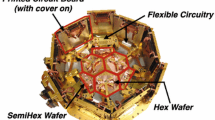Abstract
A dual-polarization InSb hot-electron bolometer-mixer receiver has been built for the James Clerk Maxwell Telescope, for operation at 461 and 492 GHz (the frequencies of theJ=4→3 rotational transition of CO and of the3 P 1→3 P 0 transition of neutral carbon). Receiver noise temperatures of 500K have been obtained at 461 GHz, in observing bandwidths of 3 MHz. The receiver was designed as a “common-user” or facility instrument. Here we describe those aspects of the design and construction which enabled this goal to be realized.
Similar content being viewed by others
References
C.A. Beichman, T.G. Phillips, H.A. Wootten & M. Frerking 1982,An upper limit to the atomic carbon abundance in the Orion Plateus, inRegions of Recent Star Formation R.S. Roger &P.E. Dewdney (eds), Riedel, Dordtrecht, pp 445–452
A. Wootten, T.G. Phillips, C.A. Beichman & M. Frerking 1982,Observations of neutral carbon in the NGC 1977 bright rim. Astrophys. J.,256, L5.
T.G. Phillips & K.B. Jefferts 1973,A low temperature bolometer heterodyne receiver for millimeter wave astronomy, Rev. Sci. Instrum.44, 1009.
T.G. Phillips 1984,InSb heterodyne receivers for submillimeter astronomy, Proc. SPIE Infrared Astronomy-Scientific/Military thrusts and in strumentation.280, 101.
T.G. Phillips 1988,Techniques of submillimeter astronomy, inMillimetre and submillimetre astronomy, R.D. Wolstencroft &W.B. Burton (eds), Kluwer, Dordtrecht, pp 1–23
Infrared Laboratories, 1808 E 17th St., Tucson AZ 85719, USA.
R. Padman 1989Optical design of dual-polarization receiver for 220–280 GHz. Int'l J. Infrared Mm Waves,10, 1233.
Cominco, Electronic Materials Division, E 15128 Euclid Ave., Spokane, WA 99216, USA
J.A. Murphy 1988,IEEE Trans. Antennas. Propagat. AP-36, 570
R. Padman, J.A. Murphy & R.E. Hills 1987.Gaussian mode analysis of Cassegrain antenna efficiency. IEEE Trans. Antennas. Propagat.AP-35, 1093.
J.A. Murphy, R. Padman & R.E. Hills 1988.An experimental submillimetre heterodyne array receiver. Int'l. J. Infrared Mm. Waves.9, 325
J.M. Dutta & H. Davé 1986,Complex dielectric constants for selected near-millimeter-wave materials at 245 GHz., IEEE Trans. Microwave Theory Tech.MTT-34, 932.
Ferroflow; Microwave Filter Co. (MFC), 6743 Kinne St., East Syracuse NY 13057, USA.
W.J. Smith 1978,Image formation: Geometrical and Physical Optics. inHandbook of Optics, W.G. Driscoll &W. Vaughan (eds), §44, p2–55. McGraw-Hill, NY.
Millitech Corp., South Deerfield, MA, USA.
R. Padman & D.W.J. Bly 1992.Spectral baseline ripple in hot-electron bolometer mixers due to local oscillator phase and amplitude instabilities. This volume.
PTS-160 synthesizer: Programmed Test Sources, 9 Beaver Brook Rd., Littleton MA 01460, USA.
Motorola MC12040
Comlinear Corporation, Fort Collins CO 80525, USA.
S. Weinreb 1983.Short term phase stability requirements for interferometer coherence. NRAO EDIR #233
E.R. Brown 1985.Ultra-low-noise, high-impedance preamp for cryogenic detectors. Electronics Lett.21, 417.
M.F. Kimmit 1970.Far-Infrared techniques. Pion Press Ltd, London.
The transistor and diode data book, Vol.2, Texas Instruments 1974.
R. Umathen 1983.Amplifiers for intermediate frequencies with extremely low noise characteristics. Cambridge University Dep't of Physics CPGS dissertation.
Ferranti Limited, Oldham U.K.
S. Weinreb 1981.Square-law detector tests. NRAO EDIR #214.
F. Arams, C. Allen, B. Peyton and E. Sand 1966.Millimetre mixing and detection in bulk InSb. Proc. IEEE54, 612
J. A. Murphy, 1986.A heterodyne array receiver for submillimetre wave astronomy. Ph.D. thesis, University of Cambridge.
R. Padman and R.E. Hills, 1991.VSWR reduction for large millimetrewave Cassegrain radiotelescopes. Int'l J. Infrared Mm. Waves12, 589.
G. J. White and R. Padman 1991.Images of atomic carbon in the interstellar medium. Nature354, 511.
Author information
Authors and Affiliations
Rights and permissions
About this article
Cite this article
Padman, R., White, G.J., Barker, R. et al. A dual-polarization InSb receiver for 461/492 GHz. Int J Infrared Milli Waves 13, 1487–1513 (1992). https://doi.org/10.1007/BF01009232
Received:
Issue Date:
DOI: https://doi.org/10.1007/BF01009232




